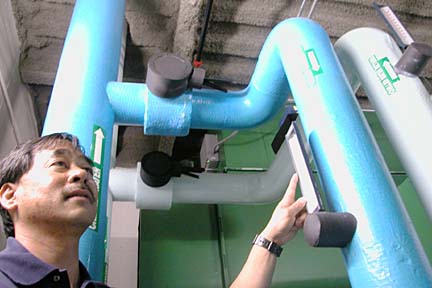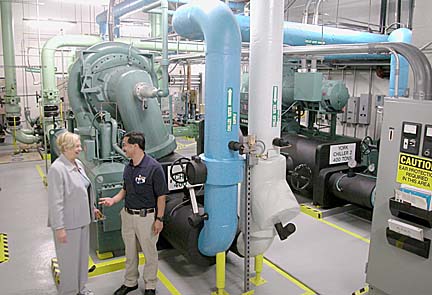


|
A major Hawaii business pays customers to use less of its product. That may sound like a strange way top do business, but Hawaiian Electric Co. says it makes good sense. If total electricity consumption can be held down, the utility can put off the huge capital expenditure that would be needed to build new generating plants.
Hawaiian Electric pays building owners
Different approaches
to install energy-efficient equipmentBy Russ Lynch
rlynch@starbulletin.comThat is worth paying for, by way of rebates to operators of buildings that take energy-saving steps, HECO officials say.
There are also environmental considerations and the desire to reduce Hawaii's dependence on oil, but a big thrust of the utility's energy conservation activity now is in changing businesses' energy-wasting ways, said Keith Block, manager of the program that HECO calls Energy Solutions for Business.
It makes sense for the electric company to offer financial rewards. HECO will pay part of the cost for a building owner to hire an engineer to do energy planning. It joins in the consulting, providing help from its own experts. It pays companies rebates on their electricity bills if they install or retrofit lighting, air conditioning and other equipment to use less electricity.

|
The program has meant big money for customers since it started in 1996, from getting financial help to plan and install equipment to saving on their electricity bills because of increased efficiency."We've paid out $10 million worth of rebates to commercial and industrial customers," Block said, "and those rebates have then encouraged them to invest another $59 million in projects" to cut energy use.
A rough calculation showed that the projects will save energy over time and that participating companies will save $240 million over the life of the new equipment, he said.
HECO earmarked $1.6 million for rebates to be paid out in 2002 and has already paid about one-third of that.
The company is constantly looking for new programs. Under one recently announced program those who qualify can get a rebate of 35 cents for every square foot of window film that cuts the sun's heat coming into a building.
HECO helps sponsor installation of low-energy fluorescent lighting, high-efficiency pumps, motors and air conditioning, and other equipment.
One recent example:
The Marriott Waikiki Beach Resort received a check for just under $98,000 to help pay for energy-efficient lighting, air conditioning and compact fluorescent lights for the hotel's guest rooms.
Block's office puts out what it calls its "Power Book," a 12-page summary of its energy programs for business and it contains other examples. They include a $3,975 rebate for Zippy's Kahala restaurant to help pay for high-efficiency air conditioners that are estimated to save the restaurant $3,300 a year.
Meadow Gold Dairies got a $5,700 rebate for replacing its lighting system with more-efficient fluorescents that use special reflectors and other features estimated to save the business $21,000 a year.
"Eventually, when the economy grows, we'll have to build another power plant. That's extremely costly and it would cost everybody, in higher rates," Block said.
The longer that can be put off the better, not just for the electric company but for the consumer, he said.

|
The problem all electric utilities have is that they have to be able to meet the total possible demand from all the customers they serve, even though those demand peaks may be rare.Taking the present value of the capital that would be used for new plant and applying it instead to programs that conserve electricity is a wise bet, he said.
Using it up
About 25 percent of electricity consumed in a typical office building goes for lighting. Cutting that use can provide a large savings. Ways to do that include using newer types of lamps and controlling them with computers so they are dimmed or off when specific areas are not being used.A building can save 30 percent of its lighting cost by taking out old, thick fluorescents and replacing them with new thin versions, Block said. A HECO rebate can take care of about 30 percent of the cost of making the change, he said.
Heating, ventilation and air conditioning make up almost half of a building's electricity consumption, HECO said. It costs money to install new energy-efficient equipment to handle that demand but it can save money in the long run.
Not all projects will qualify for HECO's help. For instance, there has to be clear evidence that there will be electricity savings in the near future. A project that cannot demonstrate savings would not qualify.
HECO has formulas to figure out the qualifications, based on the rate of return and the effectiveness of the particular work the business wants to do.
Another form of help is financing to help pay an independent engineer to study a building and come up with energy solutions.
One such engineer is Darren Kimura of Pacific Energy Services Co. His company worked closely with the operators of Alii Place, an office building on Alakea Street.
Alii Place was built in 1992. Only a year later, beginning to be aware of energy costs, it tinted its windows. With help from Kimura's firm and HECO, the building over the past several years has made a number of other changes.
The building recently was awarded the Energy Star award from the Environmental Protection Agency, the first privately owned office building in Hawaii to get that recognition. The Prince Kuhio Federal Building received the same award in 1999.
Alii Place owner Bristol Group has spent more than $1 million in energy improvements over a few years.
Among the changes was a major improvement in the air conditioning system by installing new energy-efficient chillers and "soft-start" motors. Kimura said those motors get up to speed slowly so they don't suck up a blast of electricity just to get them turning when they are activated.
Kimura did not have specific information on how much that would save, because of variables such as how often the air conditioner motors need to kick in.
But typically a combination of changes that would include new motors and chillers, will cut energy costs by nearly one-third, he said.
One-third of all office buildings in the United States have the new motors, Kimura said.
The building has a digital energy management system, which controls the use of electricity throughout the building. Each floor has its own control room. Each individual office has its own air flow controls.
"Our industry is all about payback," Kimura said, spending a little extra now for a long-term return in electricity savings.
The EPA's investigation to qualify Alii Place for the Energy Star rating was very thorough and took about two years, Kimura said.
The award recognizes that Alii Place is among the top 25 percent of the nation's commercial buildings for energy conservation.
The Alii Place complex has 360,000 square feet of space in two buildings, one of 23 floors and the other, nine.
How much electricity is devoted to uses in a typical office building: Where it goes
HVAC*42.9%
Lighting26.5%
Office equipment16.9%
Misc.13.5%
Heating water0.1%
* Heating, ventilation, air conditioning.
Source: Hawaiian Electric Co.
BACK TO TOP
|
Businesses tackle energy
efficiency differentlyMany Hawaii businesses have tackled energy efficiency. One way is in increasing use of photovoltaic systems, panels of cells that turn energy from the sun into electricity that can run motors, air conditioners or lights, unlike other solar systems that use the sun only to heat water.
>> JN Automotive Group has a rooftop photovoltaic panel helping to power a Chevrolet dealership in Honolulu.For more information on the systems, check the Web site of the energy division of the state Department of Business, Economic Development & Tourism, www.state.hi.us/dbedt/ert/pv_hi.htmlOwner Joe Nicolai, the prime mover behind the 40-story World Trade Center proposed for Kapiolani Boulevard, said he wants to use photovoltaic and other energy-saving devices with the goal of making the new high-rise completely self-sufficient.
>> The Mauna Lani Bay Resort on the Big Island installed a 100-kilowatt photovoltaic power plant in May 1998 and added a 110-kilowatt unit in January 1999.
They produce power for lighting and for charging golf-cart batteries. The resort is even going photovoltaic for the carts themselves, with individual units on each cart.
>> Farther along the Big Island coast, the Hapuna Beach Prince Hotel has a smaller photovoltaic system, 20 kilowatts, and bought its own fleet of solar-powered golf carts.
>> Owners of homes isolated in parts of the Big Island that are hard to connect to the Hawaii Electric Light Co. grid have been arranging to lease or purchase home photovoltaic units through Helco.
>> Panels power lights for parks and sports facilities elsewhere in the state.
Other Web sites with information for business and private energy consumers include DBEDT's energy resources offices at www.state.hi.us/dbedt/ert, and the federal energy network at www.eren.doe.gov/buildings.
There are also energy information pages on Hawaiian Electric's site at www.heco.com.